Have you ever wondered about the closest galaxies to the Milky Way, and whether or not it's possible to see them from planet Earth? The answer is yes, provided you know how to find them. Our galaxy is just one member of the so-called Local Group, which is our galactic neighbourhood.
This wasn't always known, however. In 1920, astronomy's Great Debate saw the subject of galaxies and the scale of the Universe put under the spotlight.
In this guide, we're going to reveal the top targets in the Local Group of galaxies, and how you can observe them through your telescope.
The Local Group includes two spiral galaxies (the Andromeda Galaxy, M31, and the Triangulum Galaxy, M33 seen above); two satellites of our Milky Way (the Large and Small Magellanic Clouds); the companion galaxies to M31; and several outlying galaxies (NGC 185 and 147), along with dozens of dwarf galaxies too faint for us to view.
From the Northern Hemisphere, several of the major galaxies of our Local Group can be seen in the autumn night sky, so let’s go on an extragalactic tour to see those that are accessible with modest equipment.
More deep-sky observing guides:
- Deep-sky astronomy: a beginner's guide
- Caldwell Catalogue: an astronomy tour of the night sky
- Explore the sights of Ursa Major
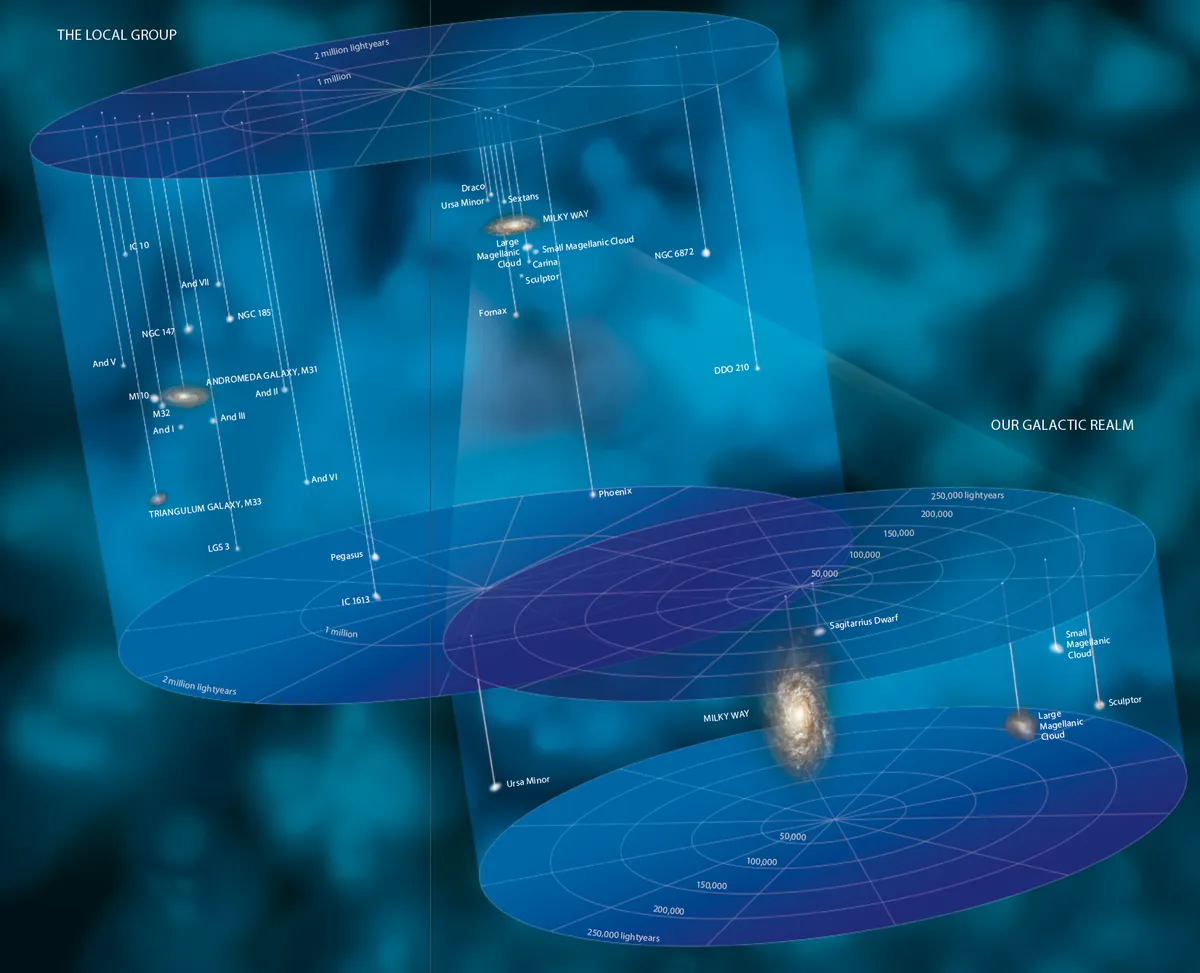
Discovering galaxies beyond our own
We used to think we lived in an ‘island universe’ consisting only of our Milky Way.
Many of the faint smudges once called 'nebulae' turned out to be other island universes too, our view of the Universe being fundamentally altered in 1924 when Edwin Hubble proved they were galaxies much like our own.
As time went by, we found these galaxies liked to form groups, and it was quickly observed that we were part of one, which was imaginatively named the ‘Local Group’.
Our astronomy tour of the Local Group of galaxies
1
The Andromeda Galaxy
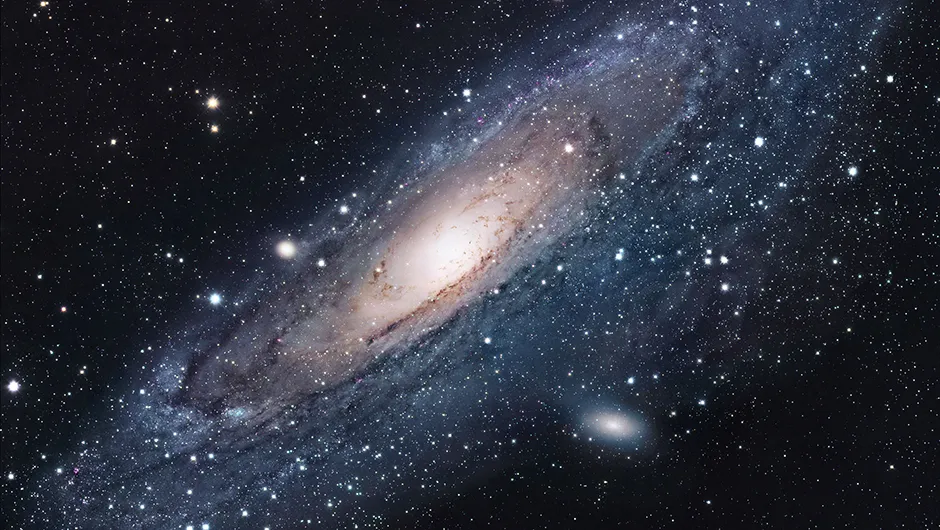
We'll start with perhaps the most famous of them all, the Andromeda Galaxy, M31. To see the Andromeda Galaxy locate the Great Square of Pegasus (see chart below) and its top, left-hand bright star Alpheratz, or Alpha (α) Andromedae (which used to be designated Delta (δ) Pegasi).
Move a little to the left to find Delta (δ) Andromedae and then continue left to the next bright, orange-looking star, which is Mirach, or Beta (β) Andromedae.
Next, we take a sharp right turn up to Mu (μ) Andromedae and move a little further on to Nu (ν) Andromedae. Here, just to one side of Nu is a hazy, naked-eye patch of light – the core of the Andromeda Galaxy.
Take in M31’s patch of light with the naked eye. Often regarded as the furthest you can see with your eyes on a dark, moonless night, it takes an estimated 2.5 million years for the light from the Andromeda Galaxy to reach our eyes, so don’t blink!
Some records suggest it may have been noted as a little cloud by Persian astronomers as early as AD 905, while Charles Messier added it to his famous Messier Catalogue in 1764.
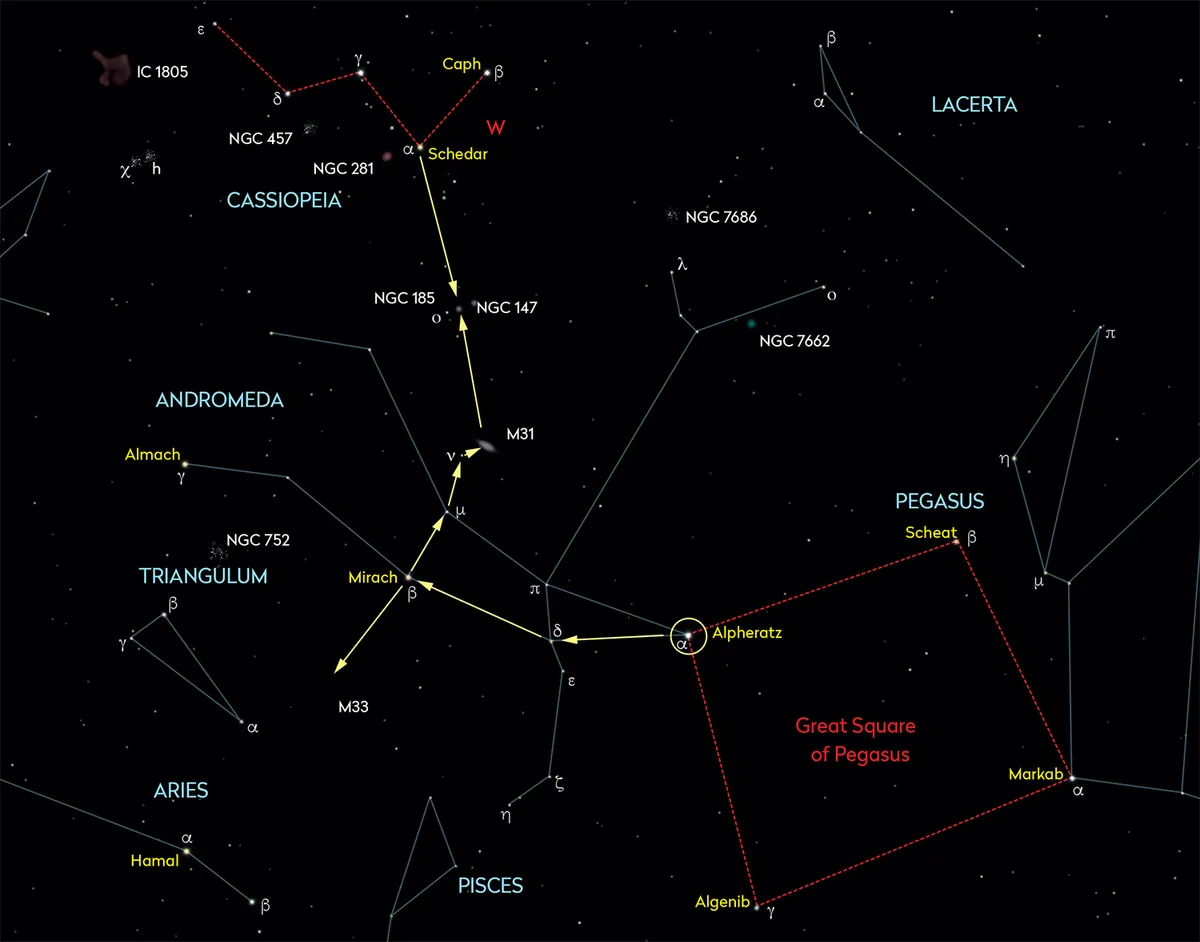
When viewing M31, try using averted vision – the art of looking slightly to its side. This will bring out fainter detail and more of an extended haze either side of the core, which is some of the Andromeda Galaxy’s disc.
Binoculars or a telescope will bring out even more of this hazy disc, and maybe hints of a spiral arm. This nearer arm is more sharply defined due to lanes of dust, which are often well seen in astrophotos.
In binoculars M31’s disc extends 3˚ from one side to the other, and it stretches even further when photographed.
The galaxy is tilted at about 13˚, which puts its central bulge and the tightly wrapped spiral arms nicely on view. It is amazing to think that M31 may contain over a trillion stars, according to data from the Spitzer Space Telescope, making it much larger than our own Milky Way.
2
M32
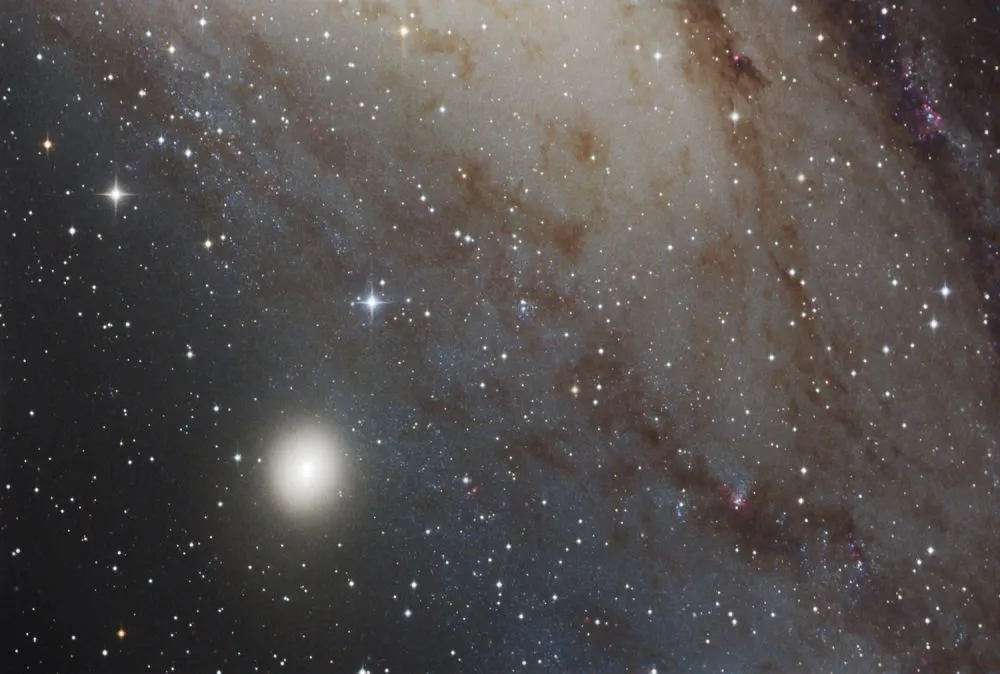
Binoculars mounted on a tripod for stability should show there are two companions to the Andromeda Galaxy – M32 and M110 – roughly either side of the central bulge.
M32 lies close to the apparent edge of the bulge, but careful observation may just make out that the faint part of the bulge can extend past it.
M32 is an elliptical galaxy with little in the way of gas and dust left, literally just a mass of stars, glowing at mag. +8.1 with its major axis pointed roughly towards the centre of the Andromeda Galaxy.
It makes a triangle with two ninth magnitude stars and there is a seventh magnitude star nearby too, which helps locate it.
3
M110
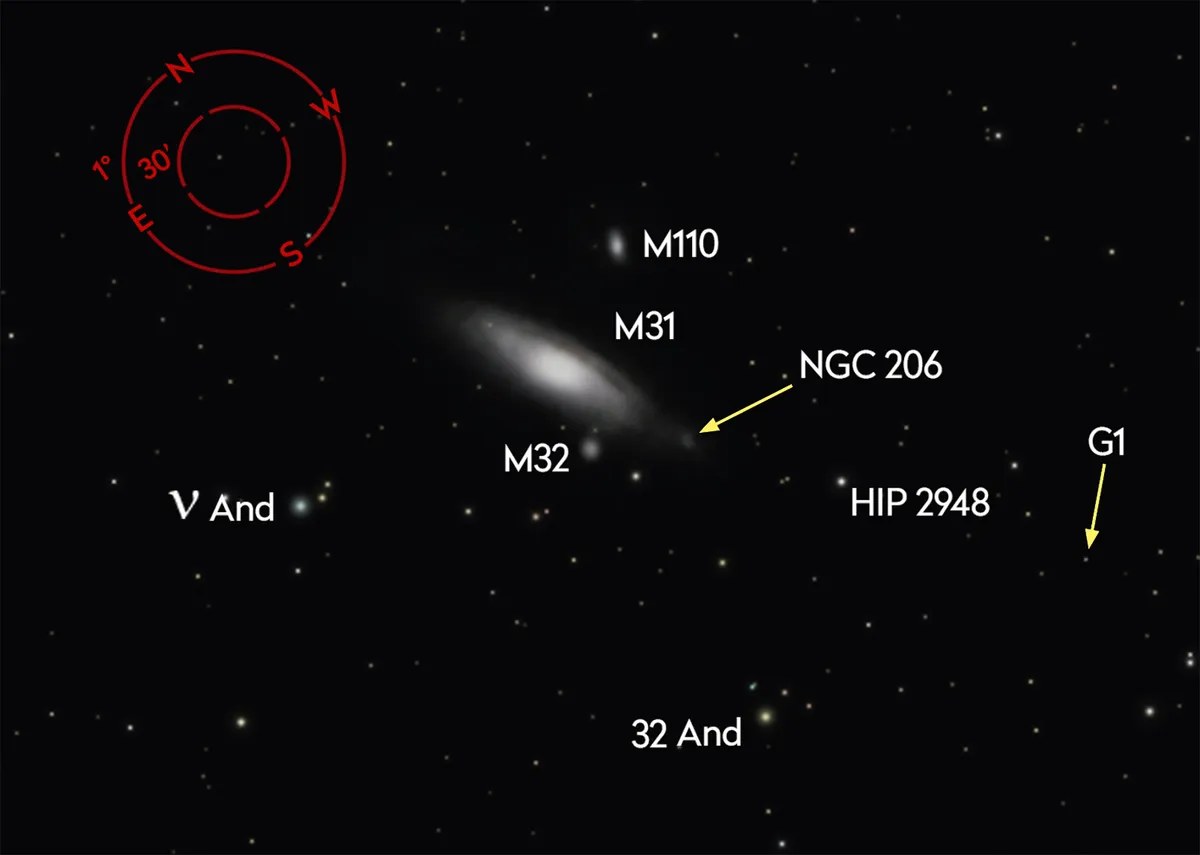
Across from M32, past the Andromeda Galaxy’s central bulge, we find M110.
This is another elliptical galaxy, shining at mag. +8.5, but it’s slightly larger than M32 and appears a little fainter because of its diffuse nature.
Both galaxies are gravitationally tied and effectively in orbit around the Andromeda Galaxy, so you could say we are seeing three galaxies for the price of one when we view it.
4
NGC 206
M31 has a few more tricks up its sleeve. With a telescope you can bring out further detail, such as its dust lanes and also a star cloud, NGC 206, of which there are similar objects in our own Milky Way, like M24, the Sagittarius Star Cloud.
NGC 206 does require medium to large telescopes to bring out its nature visually, and it can be photographed with wide, rich-field telescopes too.
5
Globular Clusters
There are also the globular clusters surrounding the Andromeda Galaxy to seek out. Again, large aperture is best: the brightest, G1 (also known as Mayall II), located 2.5˚ southwest of M31’s centre, glows at mag. +13.81 and is best seen in 10-inch or larger telescopes.
6
The Triangulum Galaxy
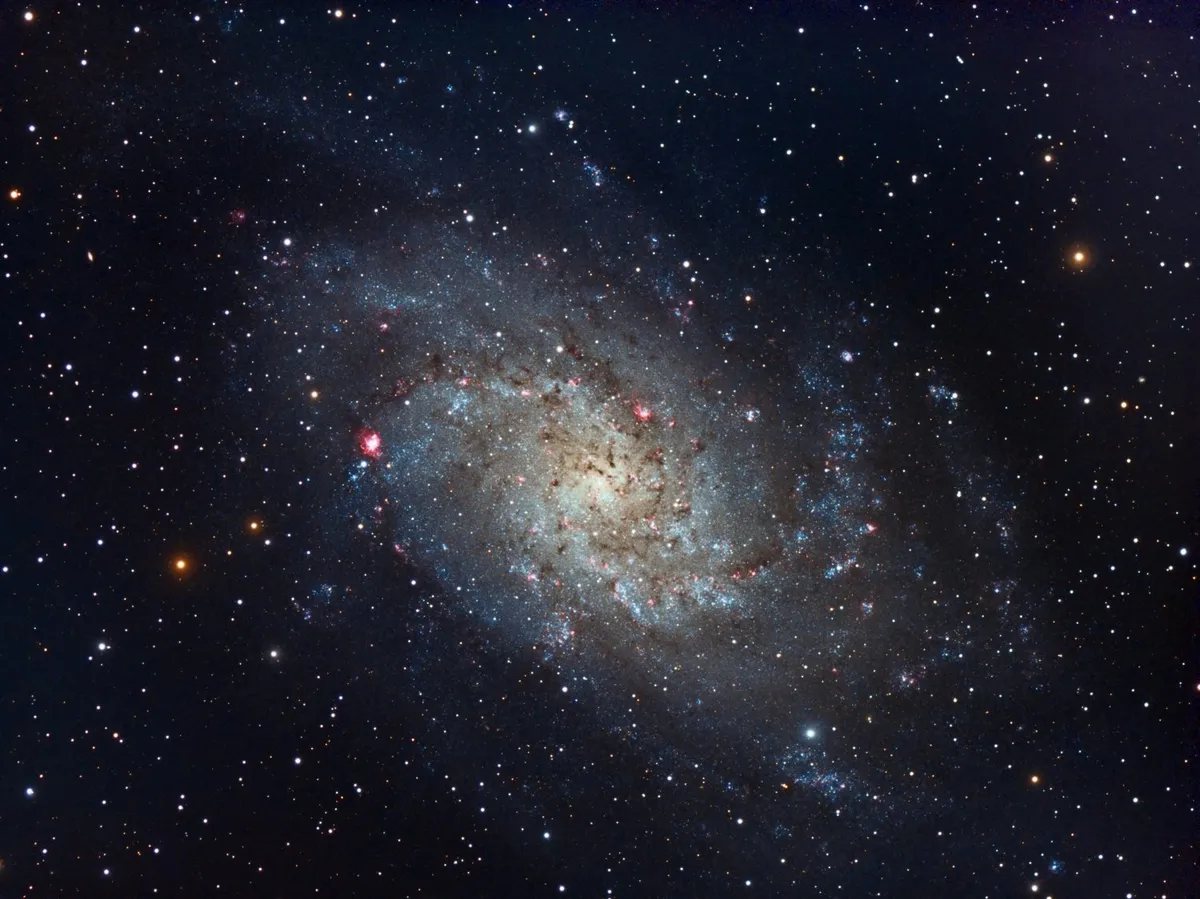
Now, let us turn to our next Local Group target, the Triangulum Galaxy M33, located in the Triangulum constellation.
Locate it from Mirach, Beta (β) Andromedae. It’s the same distance away from this star as M31, just in the opposite direction (see the star-hopping chart towards the top of the page). You’re looking for a small, hazy patch.
Despite technically being a naked-eye object at mag. +5.5, M33 doesn’t seem to be as easy to spot as you might think, so binoculars will be useful here. It doesn’t have the large, bright central bulge of M31.
This is down to the fact M33 is almost face-on to us and, without a bright central bulge, it is quite diffuse.
Yet from a dark, moonless site it is possible to spot it with the naked eye if you have keen eyesight. If you do, then you have just pushed your viewing distance out to an impressive 2.73 million lightyears.
With a telescope, M33 will show a hazy patch of light that hints at a spiral shape and it contains a wonderful surprise.
7
NGC 604
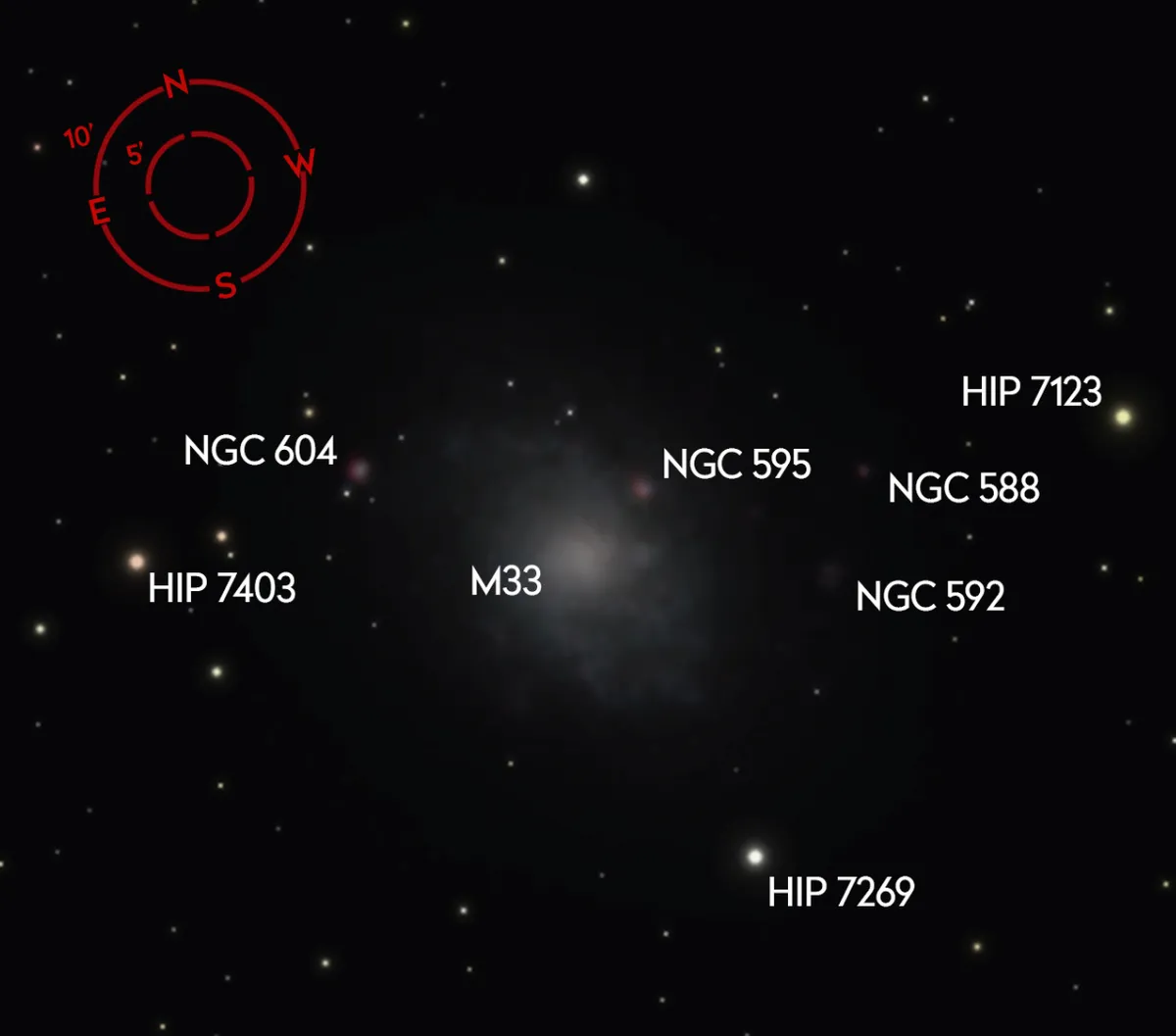
There is a large, gaseous nebulae located in M33's spiral arms, similar to the Milky Way’s Orion Nebula but around 10 times larger. This is NGC 604, which shines at mag. +12.0 and is estimated to be 1,500 lightyears across.
It takes an 8-inch telescope, or larger, to really pick it out clearly against the haze of M33’s spiral disc. If you enjoy challenges, it’s worth exploring M33’s disc carefully to see if you can spot other similar nebulae such as NGC 595, NGC 592 and NGC 588, which are all fainter than NGC 604.
8
NGC 185 & NGC 147
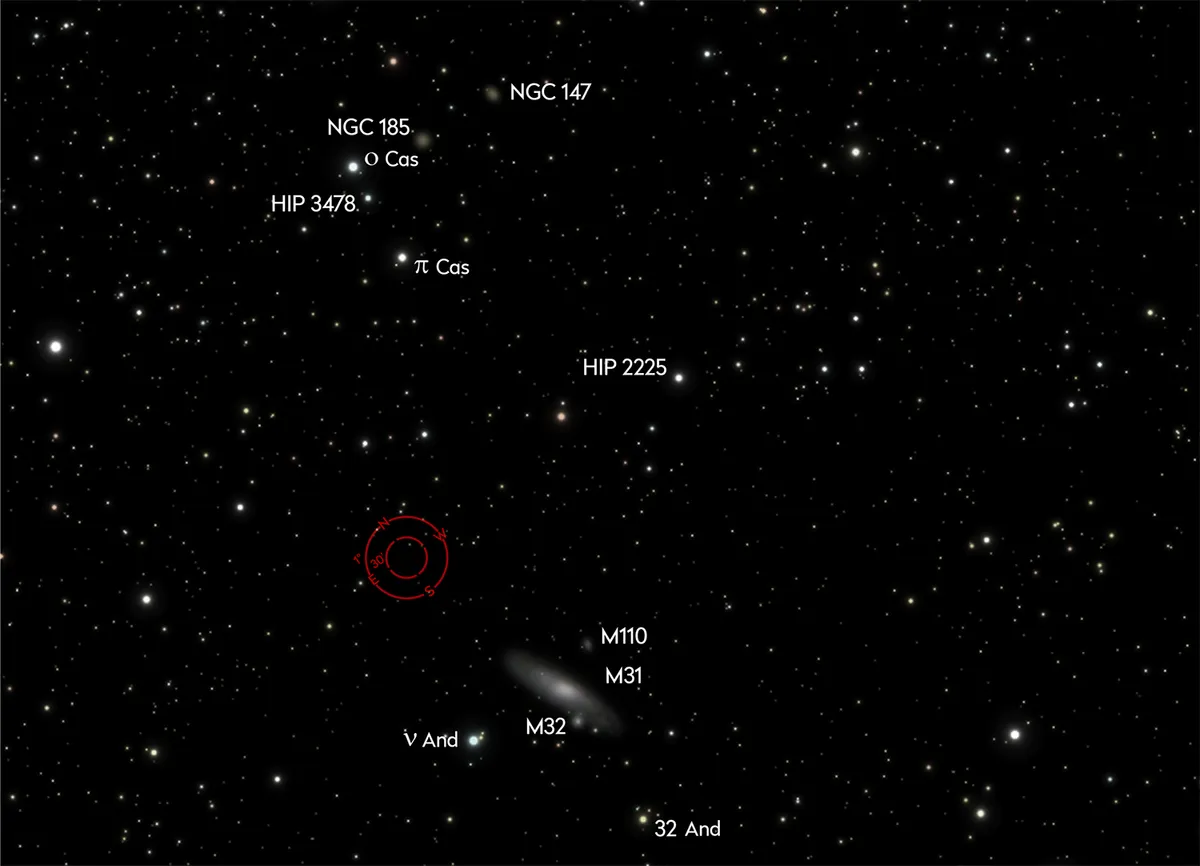
Now we’re going to seek out the other two Local Group galaxies that are currently on show for Northern Hemisphere viewers: NGC 185 and NGC 147, also known as Caldwell 18 and 17 respectively.
To find them, start at M31 and trace a line from there to Schedar, or Alpha (a) Cassiopeia (see star-hopping chart on p62).
With at least a 6-inch reflector or a 4-inch refractor, look roughly halfway along this line for a glimpse of the brighter of the two Local Group galaxies.
This is the dwarf spheroidal galaxy NGC 185, which is a small hazy patch of light, glowing at mag. +9.2 a degree westward of the mag. +4.5 star Omicron (ο) Cassiopeia (see chart, right).
Extend the line between NGC 185 and Omicron Cassiopeia by another degree westwards to find the fainter smudge of light that is NGC 147. This is also a dwarf spheroidal galaxy glowing at mag. +9.7, so fainter and requiring a little more patience to pick out.
Both are satellites of the Andromeda Galaxy and lie slightly closer to us at 2 to 2.5 million lightyears. Interestingly, they appear to be gravitationally connected to each other.
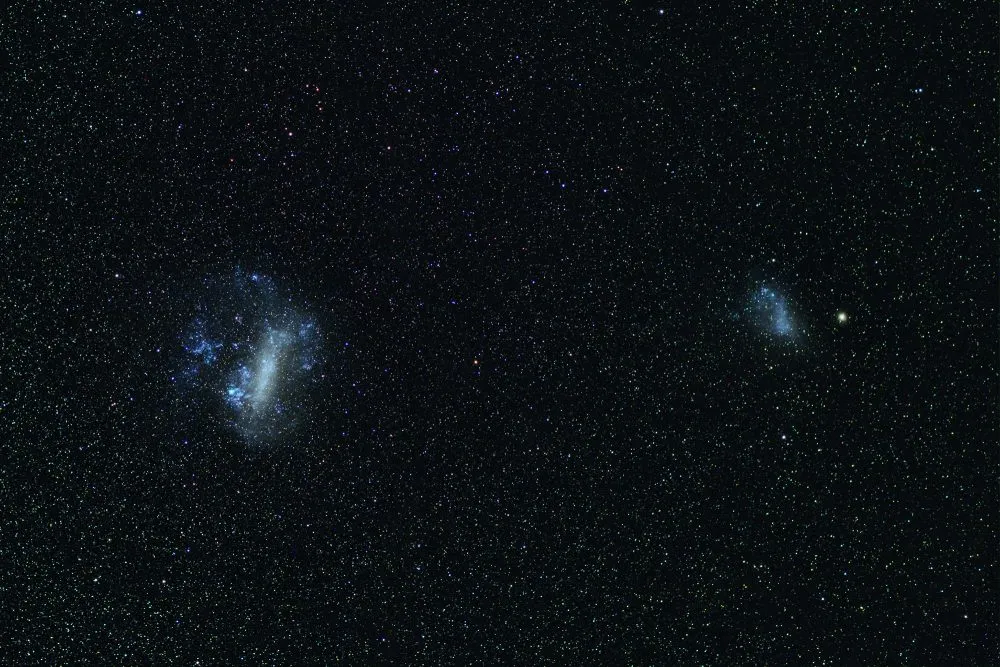
More Local Group observations
These are the Local Group galaxies that are visible in this part of the sky from the Northern Hemisphere. Other members include Leo I, a diffuse elliptical galaxy of mag. +10.4, which lies just above Regulus; and Leo II, a very faint diffuse galaxy at mag. +11.0, which lies above Delta (δ) Leonis.
Both are in the morning sky and are satellites of our Galaxy, but they are particularly tough to spot due to their spread-out, diffuse nature.
Southern Hemisphere Local Group
In the Southern Hemisphere, Local Group members include the Large and Small Magellanic Clouds, which are naked-eye objects and satellites of our own Milky Way.
The Andromeda Galaxy, M31, also has numerous satellite galaxies that are too faint for most backyard enthusiasts, but it’s possible that imaging technology may allow them to be spotted.
In recent years the members of the Local Group have increased as a result of the detection of many faint dwarf and sub dwarf galaxies. At the time of writing there are an estimated 80 members, most too faint to be seen in a backyard telescope, but it is possible that our own Milky Way Galaxy’s disc may hide others from view.
Equipment you will need to view galaxies in the Local Group

Our Local Group tour can begin with the naked eye which, depending on how dark your sky is, can show M31 and possibly M33.
A humble pair of binoculars – 7x50s to 15x70s – will reveal the galactic disc of M31, show M33 as a hazy glow and bring out M31’s two primary companions.
A wide-field telescope will improve the discs of both galaxies and make the dust lanes of M31 apparent. We used a 100mm spotting scope to track down the galaxies NGC 185 and the fainter smudge of NGC 147.
Larger scopes – 10-inch reflectors and above – will make short work of these two, but won’t reveal more detail.
Turning such scopes on M33 reveals some of its nebulae, like NGC 604. With a 10-inch reflector, M31’s disc begins to reveal similar features, like star cloud NGC 206, with more defined edges to its dust lanes.
The latest high-tech scopes will take you deeper. With live-stacked images in its electronic eyepiece, Unistellar’s eVscope (read our full eVscope review) can show fainter objects and colour in many of them.
Stacking images live via software can also bring more of these Local Group objects into view for public outreach events. Alternatively, the OVNI-M Series Night Vision Eyepiece uses phosphorous to intensify the view through any scope.
Equipment you will need to photograph galaxies in the Local Group
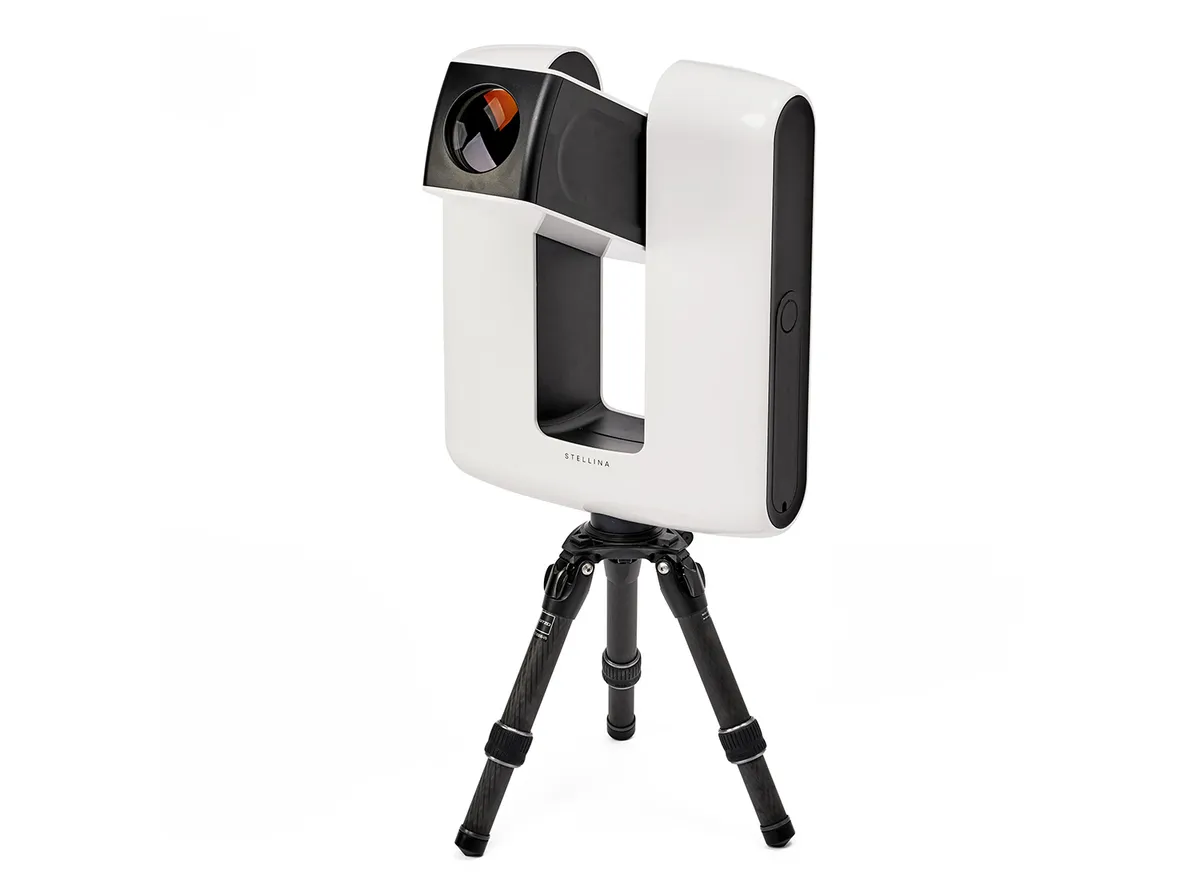
We live in amazing times, where smartphones can take images of the constellations and pick up both the Andromeda and Triangulum Galaxies in the Northern Hemisphere, and the Magellanic Clouds in the Southern Hemisphere.
Moving up to DSLRs, with a wide-field lens and a high ISO capability, you’ll also be able to image them, especially when fitted to a portable tracking mount.
By adding shorter focal-length lenses, the two companions of M31 can also be captured, along with the disc of the Andromeda Galaxy.
Even more detail can be imaged with an equatorial mount as a platform, either by taking long, guided exposures or by stacking lots of short exposures through a telescope.
This will capture the dust lanes of the Andromeda Galaxy, NGC 185 and NGC 147, and some of the nebulous parts of the Triangulum Galaxy such as NGC 604.
Increasing the aperture of your telescope and using a deep-sky CMOS or CCD camera will add even more detail and allow you to image the globular clusters of the Andromeda Galaxy too.
By using either an automated remote imaging setup or the Stellina imaging system (read our full Stellina review) it’s now possible to capture not just the popular members of the Local Group, but also many of the fainter targets.
Paul Money is an astronomy writer and broadcaster, and is reviews editor for BBC Sky at Night Magazine. This guide originally appeared in the October 2020 issue of BBC Sky at Night Magazine.
